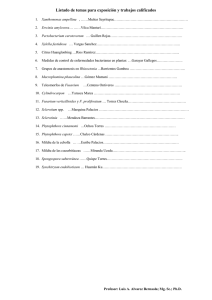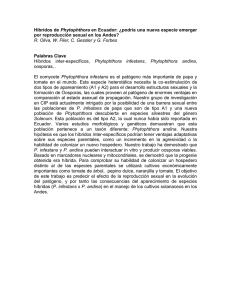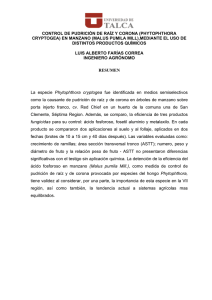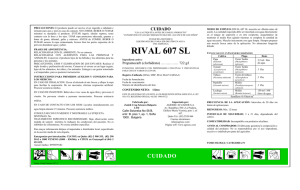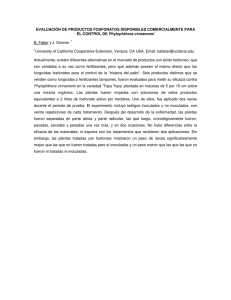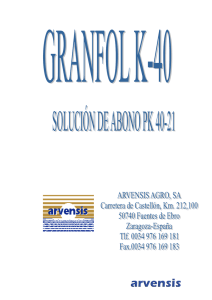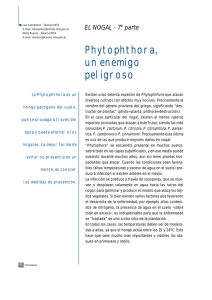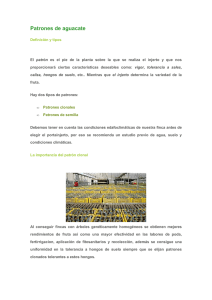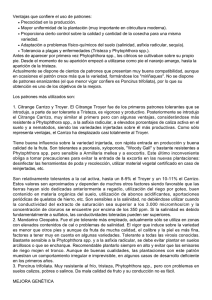ProtocolosdeaislamientoydiagnsticodePhytophthoraspp.enfoqueaplicadoalainvestigacin
Anuncio
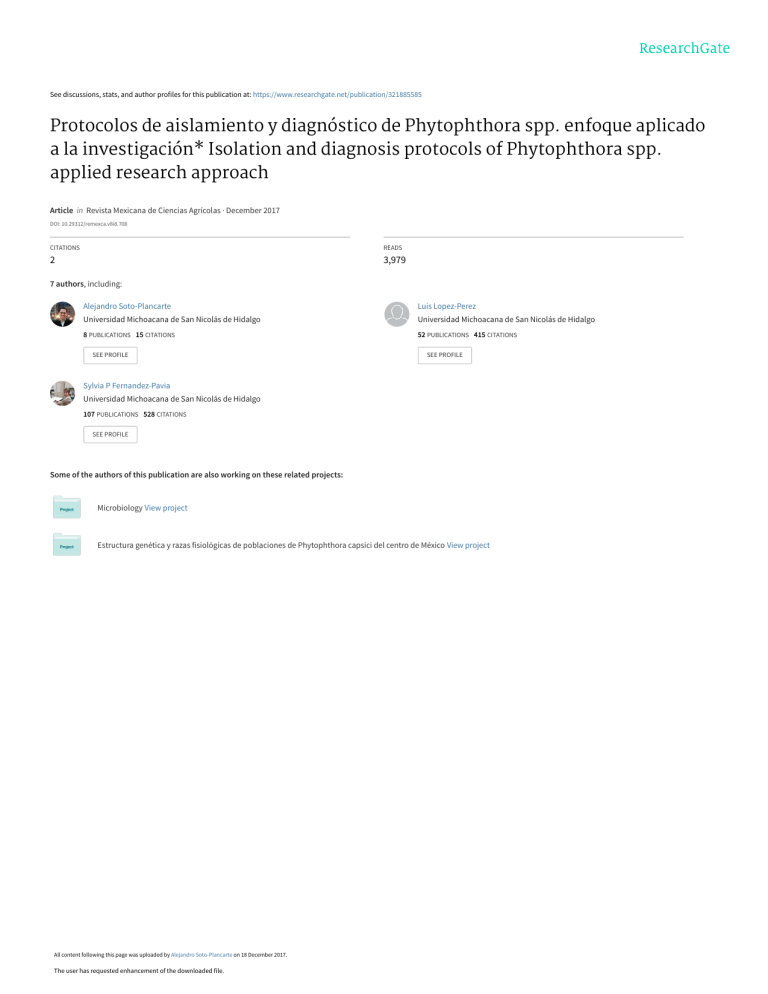
See discussions, stats, and author profiles for this publication at: https://www.researchgate.net/publication/321885585 Protocolos de aislamiento y diagnóstico de Phytophthora spp. enfoque aplicado a la investigación* Isolation and diagnosis protocols of Phytophthora spp. applied research approach Article in Revista Mexicana de Ciencias Agrícolas · December 2017 DOI: 10.29312/remexca.v8i8.708 CITATIONS READS 2 3,979 7 authors, including: Alejandro Soto-Plancarte Luis Lopez-Perez Universidad Michoacana de San Nicolás de Hidalgo Universidad Michoacana de San Nicolás de Hidalgo 8 PUBLICATIONS 15 CITATIONS 52 PUBLICATIONS 415 CITATIONS SEE PROFILE SEE PROFILE Sylvia P Fernandez-Pavia Universidad Michoacana de San Nicolás de Hidalgo 107 PUBLICATIONS 528 CITATIONS SEE PROFILE Some of the authors of this publication are also working on these related projects: Microbiology View project Estructura genética y razas fisiológicas de poblaciones de Phytophthora capsici del centro de México View project All content following this page was uploaded by Alejandro Soto-Plancarte on 18 December 2017. The user has requested enhancement of the downloaded file. Revista Mexicana de Ciencias Agrícolas Vol.8 Núm.8 12 de noviembre - 31 de diciembre, 2017 p. 1867-1880 Protocolos de aislamiento y diagnóstico de Phytophthora spp. enfoque aplicado a la investigación* Isolation and diagnosis protocols of Phytophthora spp. applied research approach Alejandro Soto Plancarte1, Gerardo Rodríguez Alvarado1, Yolanda Leticia Fernández Pavía2, Martha Elena Pedraza Santos3, Luis López Pérez1, Marlene Díaz Celaya1 y Sylvia Patricia Fernández Pavía1§ Universidad Michoacana de San Nicolás de Hidalgo-Instituto de Investigaciones Agropecuarias y Forestales. Carretera Morelia-Zinapécuaro-Tarímbaro km 9.5, Michoacán, México. CP. 58880. 01 (443) 1940975. ([email protected]; [email protected]; [email protected]). 2Colegio de Posgraduados-Programa de Fruticultura. Carretera México-Texcoco km 36.5, Montecillo, Texcoco, Estado de México. México. CP. 56230. Tel. 01 (55) 24905471.([email protected]; [email protected]; [email protected]). 3Facultad de Agrobiología-Universidad Michoacana de San Nicolás de Hidalgo. Paseo Lázaro Cárdenas esq. Berlín, Colonia Viveros, Uruapan, Michoacán, México. CP. 60090. 01 (452) 1126710. ([email protected]). §Autora para correspondencia: [email protected]. 1 Resumen Abstract El propósito de esta revisión es dar a conocer al investigador, protocolos fundamentales que se emplean para el aislamiento, diagnóstico e identificación de Phytophthora spp., cubriendo aspectos generales del género para una mejor comprensión y análisis del mismo. Esta información será de utilidad para investigadores que trabajan con enfermedades causadas por este oomicete, y va dirigida a países de América Latina. Actualmente, se emplean métodos convencionales y moleculares para la detección e identificación de especies de Phytophthora. Los métodos convencionales incluyen el uso de claves taxonómicas, la observación de síntomas y detección de signos del patógeno en las plantas enfermas y el aislamiento del agente causal del tejido vegetal infectado, del suelo que rodea a las raíces y de las fuentes de agua utilizadas para el riego, usando medios de cultivo generales o selectivos. Los métodos moleculares proporcionan resultados que son más precisos en la identificación de Phytophthora, además de que se pueden realizar en lapsos de tiempo más cortos y no es indispensable que el investigador tenga experiencia en The purpose of this review is to make known to the researcher, fundamental protocols that are used for the isolation, diagnosis and identification of Phytophthora spp., covering general aspects of the genus for a better understanding and analysis of the same. This information will be useful for researchers working with diseases caused by this oomycete, and is mainly addressed to countries in Latin America. Currently, conventional and molecular methods are used for the detection and identification of Phytophthora species. Conventional methods include the use of taxonomic keys, observation of symptoms and detection of signs of the pathogen in diseased plants, and isolation of the causative agent of infected plant tissue, soil surrounding roots and water sources used for irrigation, using general or selective culture media. Molecular methods provide results that are more accurate in Phytophthora identification and can be performed in shorter time periods and it is not essential that the researcher has experience in aspects of the morphology of members * Recibido: agosto de 2017 Aceptado: octubre de 2017 1868 Rev. Mex. Cienc. Agríc. Vol.8 Núm. 8 12 noviembre - 31 diciembre, 2017 aspectos de la morfología de los miembros de este género. Es recomendable integrar la caracterización morfológica y molecular para la identificación, descripción y taxonomía de Phytophthora. Palabras clave: Phytophthora, aislados, medio selectivo. Las especies del género Phytophthora son patógenos hemibiotróficos de gran importancia en cultivos agrícolas y forestales ya que causan grandes pérdidas económicas en un amplio rango de especies vegetales en el mundo (Erwin y Ribeiro, 1996; Hall y Albers, 2009; Jung et al., 2000; Roy y Grünwald, 2014). Entre las especies de este oomicete que ocasionan mayores daños o pérdidas se encuentran: Phytophthora ramorum, agente causal de la enfermedad denominada muerte repentina del roble, que afecta también a otros árboles y arbustos, P. palmivora causante de la pudrición de brotes, yemas y frutos en palmas; P. capsici patógeno que causa marchitez y pudrición de la corona y raíz en chile, cucurbitáceas y otros cultivos comerciales, P. infestans causante del tizón tardío de la papa, el tomate y otras plantas de la familia Solanaceae, P. cinnamomi que infecta a más de 3 000 especies de plantas en el mundo (Erwin y Ribeiro, 1996; Cooke et al., 2000; Drenth y Guest 2004; Shearer et al., 2004; Hardham, 2005; Dart y Chastagner, 2007; Sutton et al., 2007; Brasier, 2008; Hansen et al., 2012; Jiang y Tyler, 2012; Kroon et al., 2012; Lamour et al., 2012). Esta última especie, es un ejemplo del impacto económico y ecológico que pueden llegar a tener algunas especies de Phytophthora en el ámbito mundial. Por ejemplo, se ha reportado que 2 284 (40%) de las 5 710 especies de plantas descritas en el suroeste de Australia son susceptibles a P. cinnamomi. Este patógeno le costó a la economía de Australia 1 600 millones de dólares en el transcurso de una década (Carter, 2004). El número de especies descritas del género Phytophthora se ha duplicado en la última década, y posiblemente aumente de manera considerable conforme se realicen más estudios en bosques y cuerpos de agua. Por otro lado, los análisis filogenéticos multigénicos, las técnicas moleculares, la secuenciación genómica y las bases de datos con secuencias de Phytophthora han hecho posible una identificación precisa y la determinación del número real de especies descritas de este patógeno en el mundo. En la actualidad se han descrito 152 especies pertenecientes al género Phytophthora http:// idtools.org:8080/key_server/player.jsp?keyId=48. Las Alejandro Soto Plancarte et al. of this genus. It is advisable to integrate the morphological and molecular characterization for the identification, description and taxonomy of Phytophthora. Keywords: Phytophthora, isolated, medium selective. The species of the genus Phytophthora are hemibiotrophic pathogens of great importance in agricultural and forestry crops as they cause great economic losses in a wide range of plant species in the world (Erwin and Ribeiro, 1996; Hall and Albers, 2009; Jung et al., 2000; Roy and Grünwald, 2014). Among the species of this oomycete that cause greater damage or loss are: Phytophthora ramorum, causal agent of the disease called sudden oak death, which also affects other trees and shrubs, P. palmivora causing bud rot, buds and fruits in palms; P. capsici pathogen that causes wilting and rotting of crown and root in chile, cucurbits and other commercial crops, P. infestans causing late blight of potato, tomato and other plants of the family Solanaceae, P. cinnamomi that infects More than 3,000 species of plants in the world (Erwin and Ribeiro, 1996; Cooke et al., 2000; Drenth and Guest 2004; Shearer et al., 2004; Hardham, 2005; Dart and Chastagner, 2007; Sutton et al., 2007; Brasier, 2008; Hansen et al., 2012; Jiang and Tyler, 2012; Kroon et al., 2012; Lamour et al., 2012). This last species is an example of the economic and ecological impact that some species of Phytophthora can have in the world. For example, 2 284 (40%) of the 5 710 plant species described in southwestern Australia have been reported to be susceptible to P. cinnamomi. This pathogen cost the Australian economy 1.6 billion dollars over the course of a decade (Carter, 2004). The number of species described in the genus Phytophthora has doubled in the last decade, and is likely to increase considerably as more studies are carried out on forests and water bodies. On the other hand, multigenic phylogenetic analyzes, molecular techniques, genomic sequencing and databases with Phytophthora sequences have made possible a more accurate identification and determination of the actual number of described species of this pathogen in the world. Currently 152 species belonging to the genus Phytophthora have been formally described http:// idtools.org:8080/key_server/player.jsp?keyId=48. The Phytophthora species listed on the Internet are www. phytophthoradb.org, www.phytophthora-id.org, www. qbank.eu, and www.boldsystems.org. Protocolos de aislamiento y diagnóstico de Phytophthora spp.: enfoque aplicado a la investigación páginas web que enlistan especies de Phytophthora son: www.phytophthoradb.org, www.phytophthora-id.org, www.qbank.eu, y www.boldsystems.org. Medios de cultivo Los medios de cultivo seleccionados para aislar, describir e identificar especies de Phytophthora son de suma importancia. Un factor que se debe considerar para elegir el medio apropiado es la especie de Phytophthora con la cual se esté trabajando (Erwin y Ribeiro, 1996). Los medios selectivos para aislar Phytophthora contienen fungicidas y antibióticos, para evitar el crecimiento de hongos y bacterias. Los medios selectivos generalmente más utilizados son PARPH, PARP, PARPH, PVP (P-pimaricina, A-ampicilina, R-rifampicina, P-pentacloronitrobenceno, H-himexazol, V-vancomicina), 3-P (P-pimaricina, P-Penicinila, P-Polimixina B, CARP (C-cornmeal agar <harina de maíz agar>, A-ampicilina, R-rifamicina, P-pimaricina), CARPD (D-dicloran), CARP+ (+-benlato e himexazol), existiendo variaciones en las concentraciones de los antibióticos y fungicidas que se agregan (Tsao y Ocana, 1969; Jeffers y Martin, 1986; Erwin y Ribeiro, 1996; Drenth y Sendall, 2001) estos deberán añadirse después de que el medio se ha esterilizado el medio. La pimaricina es un antibiótico costoso para los laboratorios de América Latina; sin embargo, se puede substituir por Delvocid Instant (Erwin y Ribeiro, 1996), que es de bajo costo, este contiene Natamicina por lo que a este medio se le conoce como NARPH. Asimismo el himexazol que anteriormente provenía de Japón, actualmente está disponible en diferentes países. El medio selectivo se puede preparar utilizando harina de maíz agar o V8 agar. Cuando no se pueda adquirir harina de maíz esta se puede substituir por fécula de maíz (Félix-Gastélum. Comun. Pers., 2015). Algunos ejemplos que el medio es bastante específico es el de agar centeno, que es utilizado para aislar P. infestans, P. ipomoeae y P. mirabilis, los medios 3-P y PCH (P-pimaricina, C-cloranfenicol, H-himexazol) son específicos para aislar P. cinnamomi de raíces y de suelo (Drenth y Sendall, 2001; Ivors, 2016). Los protocolos y medios (V8 agar, V8 líquido, súper V8, V8-centeno, centeno A, centeno B, harina de avena, agar zanahoria al 5%, frijol lima fresco y chícharo sacarosa), empleados actualmente se describen en el libro de Ivors (2016). En el laboratorio se pueden preparar medios de cultivo con componentes que se encuentren disponibles, se recomienda probar diferentes métodos de preparación y seleccionar los más adecuados a las necesidades individuales. 1869 Means of cultivation The culture media selected to isolate, describe and identify Phytophthora species are of paramount importance. One factor that must be considered in choosing the appropriate medium is the Phytophthora species with which it is being worked (Erwin and Ribeiro, 1996). The selective means to isolate Phytophthora contain fungicides and antibiotics, to avoid the growth of fungi and bacteria. The most commonly used selective media are PARPH, PARP, PARPH, PVP (P-pimaricina, A-ampicilina, R-rifampicina, P-pentacloronitrobenceno, H-himexazol, V-vancomicina), 3-P (P-pimaricina, P-Penicinila, P-Polimixina B, CARP (C-cornmeal agar, A-ampicilina, R-rifamicina, P-pimaricina), CARPD (D-dicloran), CARP+ (+-benlato e himexazol), there are variations in the concentrations of the antibiotics and fungicides are added (Tsao and Ocana, 1969; Jeffers and Martin, 1986; Erwin and Ribeiro, 1996; Drenth and Sendall, 2001) these must be added after the medium has been sterilized the medium. Pimaricin is an expensive antibiotic for laboratories in Latin America; however, it can be replaced by Delvocid Instant (Erwin and Ribeiro, 1996), which is inexpensive, it contains Natamycin, which is why this medium is known as NARPH. Likewise, the himexazole that previously came from Japan, is currently available in different countries. The selective medium can be prepared using corn flour agar or V8 agar. When corn flour can not be purchased, it can be replaced by corn starch (Felix- Gastelum. Comun. Pers., 2015). Some examples in which the medium is quite specific is that of rye agar, which is mainly used to isolate P. infestans, P. ipomoeae and P. mirabilis, 3-P media and PCH (P-pimaricina, C-cloranfenicol, H-himexazol) are specific for isolating P. cinnamomi from roots and soil (Drenth and Sendall, 2001; Ivors, 2016). The protocols and media (V8 agar, liquid V8, super V8, V8-rye, rye A, rye B, oatmeal, 5% carrot agar, fresh lime and sucrose), currently employed are described in the Ivors (2016). In each laboratory, culture media can be prepared with the components available, it is also recommended to test different methods of preparation and select the most suitable ones for the individual needs. Direct diagnosis When a phytopathological diagnosis is carried out, the results are expected to be obtained as quickly as possible, for which kits, ELISA tests, fluorescence in situ hybridization (FISH), Alejandro Soto Plancarte et al. 1870 Rev. Mex. Cienc. Agríc. Vol.8 Núm. 8 12 noviembre - 31 diciembre, 2017 Diagnóstico directo Cuando se lleva a cabo un diagnóstico fitopatológico se espera que el resultado se obtenga lo más rápido posible, para lo cual existen kits, pruebas de ELISA, hibridación in situ fluorescente (FISH), técnicas hiperespectrales, biosensores basados en anticuerpos, inmunoflorescencia, imágenes de florescencia, termografía, y pruebas de tiras reactivas para la detección directa de patógenos en campo que son de gran ayuda y pueden detectar Phytophthora (Miller et al., 1994; Fang y Ramasamy, 2015). La mayoría de kits de uso en campo basados en técnicas serológicas dan una respuesta rápida in situ en pocos minutos u horas, lo cual es de gran utilidad para productores, asesores, técnicos e inspectores. Las pruebas se pueden realizar a partir de cualquier tejido de la planta que se requiere analizar y el resultado es fácil de interpretar. Si se considera necesario, los resultados pueden confirmarse posteriormente en laboratorio. Algunos de los kits disponibles en el mercado son Phytophthora late blight Pocket Diagnostic® test para la detección de P. infestans en papa, Phytophthora spp. ALERTLF® y los ImmunoStrips que permiten identificar infecciones causadas por Phytophthora en un amplio rango de cultivos incluyendo plantas de vivero. Estos kits están diseñados para utilizarse en campo o laboratorio a partir de muestras de tejido vegetal, no requieren equipo especial para llevarlas a cabo, ya que todo el material requerido está incluido. Aislamiento de Phytophthora Aislamiento de Phytophthora a partir de tejido vegetal. Una adecuada colecta y selección de muestras determinan el éxito en el proceso de aislamiento de Phytophthora de tejido vegetal enfermo. Se recomienda colectar muestras de hojas, tallos, raíces, frutos, flores, etc, que tengan una zona de tejido sano frente al avance de la lesión (Figura 1). Para realizar el aislamiento se deben cortar secciones de tejido de la zona mencionada, ya que será donde el patógeno esté en crecimiento activo. Estos tejidos se pueden sembrar sin desinfestar, directamente en medio selectivo (Erwin y Ribeiro, 1996; Streito, 2002; Jung y Blaschke, 2004; Jung y Burgess, 2009; Kasuga et al., 2012). No se recomienda aislar Phytophthora de tejido necrótico debido a la presencia de hongos y bacterias saprófitos. Algunos autores sugieren desinfestar superficialmente los tejidos, para lo cual, las secciones de tejido se sumergen en etanol al 70% durante 10 a 30 s, después se lavan con agua destilada hyperspectral techniques, antibody based biosensors, immunoflorescence, fluorescence, thermography, and test strips for the direct detection of pathogens in the field that are of great help and can detect Phytophthora (Miller et al., 1994; Fang and Ramasamy, 2015). Most field-use kits based on serological techniques give a rapid on-site response in a few minutes or hours, which is of great use to producers, consultants, technicians and inspectors. Tests can be performed from any plant tissue that is required to be analyzed and the result is easy to interpret. If necessary, the results can be confirmed later in the laboratory. Some of the kits available on the market are Phytophthora late blight Pocket Diagnostic® test for the detection of P. infestans in potato, Phytophthora spp. ALERT-LF® and ImmunoStrips to identify infections caused by Phytophthora in a wide range of crops including nursery plants. These kits are designed for use in field or laboratory from plant tissue samples, do not require special equipment to carry them out, since all the required material is included. Isolation of Phytophthora Isolation of Phytophthora from plant tissue. A suitable collection and selection of samples determine the success in the process of isolation of Phytophthora from diseased plant tissue. It is recommended to collect samples of leaves, stems, roots, fruits, flowers, etc, that have a zone of healthy tissue in front of the advancement of the lesion(Figure 1). To isolate sections of tissue from the area mentioned should be cut, as it will be where the pathogen is in active growth. These tissues can be planted without disinfesting, directly in a selective medium (Erwin and Ribeiro, 1996; Streito, 2002; Jung and Blaschke, 2004; Jung and Burgess, 2009; Kasuga et al., 2012). It is not recommended to isolate Phytophthora from necrotic tissue due to the presence of fungal and saprophytic bacteria. Some authors suggest to disinfect the tissues superficially, for which the sections of tissue are immersed in 70% ethanol for 10 to 30 s, then washed with sterile distilled water, then dried with sterile filter paper and finally placed in selective culture medium (Hüberli, 2000; Davison and Tay, 2005; Ghimire et al., 2009; Moralejo et al., 2009; Tsopmbeng et al., 2012), in some reports it is mentioned that alcohol does not leave residues so it is not necessary to rinse (Martin et al., 2012; Borines et al., 2014). Protocolos de aislamiento y diagnóstico de Phytophthora spp.: enfoque aplicado a la investigación 1871 estéril, posteriormente se secan con papel filtro estéril y por último se colocan en medio de cultivo selectivo (Hüberli, 2000; Davison y Tay, 2005; Ghimire et al., 2009; Moralejo et al., 2009; Tsopmbeng et al., 2012), en algunos reportes se menciona que el alcohol no deja residuos por lo que no es necesario enjuagar (Martin et al., 2012; Borines et al., 2014). También se utiliza principalmente una solución de cloro comercial al 10% (5% hipoclorito de sodio). El proceso de desinfestación consiste en sumergir el tejido vegetal en la solución de cloro durante 30 s, enseguida enjuagar con agua destilada estéril y después secar con papel estéril, finalmente cortar las secciones de tejido antes de colocarlas en el medio selectivo (Drenth y Sendall, 2001; Ghimire et al., 2009). El tiempo de desinfestación puede variar, lo cual depende del tipo de tejido del que se va a realizar el aislamiento. Es importante tomar en cuenta que la sensibilidad al cloro varía de una especie a otra de Phytophthora. Hong et al., (2003), han mostrado que la sensibilidad a éste es patógenodependiente. Algunas especies de Phytophthora, pueden ser sensibles al cloro y al etanol por lo que se debe omitir su uso (Hong et al., 2003). Cuando se desconoce si la especie es sensible a estos compuestos, se recomienda desinfestar solo algunas secciones de tejido con etanol o cloro y otros sembrarlos directamente en medio selectivo. El tejido se debe secar preferentemente con papel filtro o toallas de papel estériles antes de sembrarse en algún medio, para evitar el crecimiento de bacterias (Erwin y Ribeiro, 1996). Las secciones de tejido sembradas en medio selectivo se deben incubar a temperatura que favorezca el crecimiento de Phytophthora (Erwin y Ribeiro, 1996; Ferguson y Jeffers, 1999; Drenth y Sendall, 2001; Martin et al., 2012). Aislamiento de Phytophthora de agua. El agua de riego es una fuente importante de inóculo de patógenos de plantas. Los géneros Phytophthora y Pythium de la familia Pythiaceae son los más comunes, destructivos y contaminantes en sistemas de riego (Erwin y Ribeiro, 1996; Drenth y Sendall, 2001; Loyd et al., 2014; Zappia et al., 2014). Se han detectado en agua más de 30 especies de Phytophthora en el mundo, con algunas especies aún no se han realizado pruebas de patogenicidad (Zappia et al., 2014) otras que se han inoculado en diferentes hospedantes no han sido patógenas (Copes et al., 2015). Únicamente se ha demostrado la patogenicidad de algunas como P. irrigata en azalea, chile y tomate; P. hydropathica en azalea, cineraria y tomate; P. megasperma en azalea y chile; Figura 1. Aislamiento de Phytophthora a partir de raíces con pudrición en medio selectivo NARPH-harina de maíz. Figure 1. Isolation of Phytophthora from roots with rot in selective medium NARPH-corn meal. A 10% commercial chlorine solution (5% sodium hypochlorite) is also used mainly. The disinfestation process involves immersing the plant tissue in the chlorine solution for 30 s, then rinsing with sterile distilled water and then drying with sterile paper, finally cutting the tissue sections before placing them in the selective medium (Drenth and Sendall, 2001; Ghimire et al., 2009). The disinfestation time may vary, which depends on the type of tissue from which the insulation is to be performed. It is important to take into account that sensitivity to chlorine varies from one species to another of Phytophthora. Hong et al., (2003), have shown that the sensitivity to this is pathogen-dependent. Some species of Phytophthora may be sensitive to chlorine and ethanol and should be omitted (Hong et al., 2003). When it is unknown if the species is sensitive to these compounds, it is recommended to disinfect only some sections of tissue with ethanol or chlorine and others to seed directly in selective medium. The tissue should preferably be dried with filter paper or sterile paper towels before being sown in any medium to prevent bacterial growth (Erwin and Ribeiro, 1996). Tissue sections seeded in selective medium should be incubated at 1872 Rev. Mex. Cienc. Agríc. Vol.8 Núm. 8 12 noviembre - 31 diciembre, 2017 P. nicotianae en vinca, begonia, berenjena, chile, cineraria, lupinus y tomate; P. palmivora en azalea, begonia, berenjena, chile y tomate; P. tropicalis en azalea, begonia, berenjena, chile, cineraria, lupinus, tomate y vinca (Hong et al., 2008; Loyd et al., 2014). Los reservorios o canales de agua para uso agrícola pueden ser contaminados por escurrimientos de agua de campos infestados con Phytophthora, lo que puede ocasionar la dispersión del patógeno a lugares donde no estaba presente (Erwin y Ribeiro, 1996). El agua recirculada infestada dentro y entre viveros favorece la dispersión de propágulos de Phytophthora en forma de zoosporas, a plantas sanas y a zonas donde no se encontraba (MacDonald et al., 1994; Stewart-Wade, 2011). Por lo que, los protocolos eficaces para detectar a este oomicete en agua de riego son esenciales. Con los métodos de filtración se pueden procesar cantidades limitadas de agua comparado con la enorme cantidad de agua que existe en las represas, cuerpos de agua y sistemas de riego. En un estudio realizado por Hong et al. (2002), obtuvieron mayores tasas de recuperación en diferentes fuentes de agua filtrando las muestras de agua a través de una membrana que retiene los propágulos, la cual posteriormente se invierte y se coloca directamente en el medio selectivo PARP-V8. Las membranas que probaron fueron de diferentes materiales y tamaños de poro observando mejores resultados con las membranas Millipore 5 y Durapore 5 (Millipore®) obteniendo mayores tasas de recuperación. Aislamiento de Phytophthora de suelo o sustrato de siembra Phytophthora puede dispersarse a nuevos sitios a través de la venta de diferentes sustratos de siembra o suelos infestados con propágulos (Ferguson y Jeffers, 1999; Dart et al., 2007; Dart y Chastagner, 2007). Se recomienda usar diferentes tejidos vegetales trampa con cada muestra de suelo o sustratos que se sospecha están contaminados con Phytophthora para descartar resultados negativos falsos (Jeffers y Aldwinkle, 1987; Davison y Tay, 2005b; Balci et al., 2007; Tooley y Carras, 2011). Una amplia gama de tejidos vegetales trampa se usan para recuperar Phytophthora de suelo ya que no todos son colonizados de la misma forma por las diferentes especies de Phytophthora (Erwin y Ribeiro, 1996). En un párrafo posterior se mencionan los tejidos vegetales trampa recomendados. Alejandro Soto Plancarte et al. a temperature favoring Phytophthora growth (Erwin and Ribeiro, 1996; Ferguson and Jeffers, 1999; Drenth and Sendall, 2001; Martin et al., 2012). Isolation of Phytophthora of water. Irrigation water is an important source of inoculum of plant pathogens. The genera Phytophthora and Pythium of the family Pythiaceae are the most common, destructive and polluting in irrigation systems (Erwin and Ribeiro, 1996; Drenth and Sendall, 2001; Loyd et al., 2014; Zappia et al., 2014). More than 30 species of Phytophthora have been detected in water in the world, with some species not yet tested for pathogenicity (Zappia et al., 2014), others that have been inoculated in different hosts have not been pathogenic (Copes et al., 2015). Only the pathogenicity of some P. irrigata in azalea, chili and tomato has been demonstrated; P. hydropathica in azalea, cineraria and tomato; P. megasperm in azalea and chili; P. nicotianae in vinca, begonia, eggplant, chili, cineraria, lupinus and tomato; P. palmivora in azalea, begonia, eggplant, chilli and tomato; P. tropicalis on azalea, begonia, eggplant, chili, cineraria, lupinus, tomato and vinca (Hong et al., 2008; Loyd et al., 2014). Water reservoirs or channels for agricultural use can be contaminated by water runoff from fields infested with Phytophthora, which may also lead to the dispersion of the pathogen to places where it was not present (Erwin and Ribeiro, 1996). Recirculated water infested within and between nurseries favors the dispersal of Phytophthora propagules in the form of zoospores, healthy plants and areas where it was not found (MacDonald et al., 1994; Stewart-Wade, 2011). Therefore, effective protocols to detect this oomycete in irrigation water are essential. Filtration methods can process limited amounts of water compared to the enormous amount of water that exists in dams, bodies of water and irrigation systems. In a study by Hong et al. (2002), obtained higher recovery rates in different water sources by filtering the water samples through a membrane that retains the propagules, which is then inverted and placed directly in the selective PARP-V8 medium. The membranes tested were of different materials and pore sizes, observing better results with the Millipore 5 and Durapore 5 membranes (Millipore®) obtaining higher recovery rates. Protocolos de aislamiento y diagnóstico de Phytophthora spp.: enfoque aplicado a la investigación Para detectar Phytophthora en suelos o sustratos, se utiliza la inundación de estos con agua destilada estéril, de tal manera que los propágulos, especialmente zoosporas se liberan en el agua, nadan a la superficie e infectan el tejido vegetal usado como tejido vegetal trampa (Figura 2). Algunas proporciones utilizadas para mezclar sustrato y agua son 1:2, 2:3.5 (peso: volumen). Este método tiene varias ventajas con respecto al aislamiento de tejido, ya que puede analizar grandes cantidades de suelo, incrementando las posibilidades de detectar el patógeno cuando la concentración de inóculo es baja. 1873 Isolation of soil Phytophthora or planting substrate Phytophthora can be dispersed to new sites through the sale of different seed substrates or propagule-infested soils (Ferguson and Jeffers, 1999; Dart et al., 2007; Dart and Chastagner, 2007). It is recommended to use different trap vegetable tissues with each soil sample or substrates suspected to be contaminated with Phytophthora to rule out false negative results (Jeffers and Aldwinkle, 1987; Davison and Tay, 2005b; Balci et al., 2007; Tooley and Carras, 2011). A wide range of trap plant tissues are used to recover Phytophthora from soil since not all are colonized in the same way by different Phytophthora species (Erwin and Ribeiro, 1996). In a later paragraph the recommended trap vegetable tissues are mentioned. To detect Phytophthora in soils or substrates, flooding of these with sterile distilled water is used, in such a way that propagules, especially zoospores are released into the water, swim to the surface and infect the plant tissue used as trap plant tissue (Figure 2). Some proportions used to mix substrate and water are 1:2, 2:3.5 (weight: volume). This method has several advantages over tissue insulation, since large amounts of soil can be analyzed, increasing the chances of detecting the pathogen when the inoculum concentration is low. Figura 2. Hojas de Rhododrendron utilizadas como tejido vegetal trampa para detectar la presencia de Phytophthora en muestras de substrato o suelo, en cajas de Petri. Figure 2. Rhododendron leaves used as plant tissue trap to detect the presence of Phytophthora in substrate or soil samples, in Petri dishes. Asimismo, es más factible detectar las oosporas en especies homotálicas (Erwin y Ribeiro, 1996; Balci et al., 2007; Fichtner et al., 2007). Los tejidos vegetales trampa colonizados por zoosporas posteriormente se lavan con agua de la llave o destilada estéril para eliminar bacterias de la superficie del tejido, se secan con papel estéril y se siembran en medio selectivo (Ferguson y Jeffers, 1999; Jung et al., 2000; Balci et al., 2007; Fitchtner et al., 2007; Hwang et al., 2008; Ghimire et al., 2009). El peciolo de las hojas de Rhododendron es el tejido que se infecta primero, por lo que éste se puede cortar y sembrar en medio selectivo (Figura 3). It is also more feasible to detect oospores in homotactic species (Erwin and Ribeiro, 1996; Balci et al., 2007; Fichtner et al., 2007). Zoospore-colonized trap tissues are subsequently washed with tap water or sterile distilled water to remove bacteria from the tissue surface, dried with sterile paper and seeded in selective medium (Ferguson and Jeffers, 1999; Jung et al., 2000; Balci et al., 2007; Fitchtner et al., 2007; Hwang et al., 2008; Ghimire et al., 2009). The petiole of Rhododendron leaves is the tissue that is generally infected first, so that it can be cut and planted in selective medium (Figure 3). The collection of samples for purposes of detection or population density should be performed in the different seasons of the year since populations may vary from one station to another (Erwin and Ribeiro, 1996). Most species of Phytophthora are favored by conditions of high humidity, temperatures between 15 and 35 °C, humid climates with abundant rains and nutrient-poor substrate or soil. When these conditions are present, it is advisable to analyze samples of the substrate or soil to detect the pathogen (Erwin and Ribeiro, 1996; Drenth and Sendall, 2001; Kong et al., 2009). Alejandro Soto Plancarte et al. 1874 Rev. Mex. Cienc. Agríc. Vol.8 Núm. 8 12 noviembre - 31 diciembre, 2017 La colecta de muestras para propósitos de detección o densidad poblacional debe realizarse en las diferentes estaciones del año ya que las poblaciones pueden variar de una estación a otra (Erwin y Ribeiro, 1996). La mayoría de las especies de Phytophthora son favorecidas por alta humedad, temperaturas entre 15 y 35 °C, climas húmedos con lluvias abundantes y sustrato o suelo pobres en nutrientes. Cuando se presenten estas condiciones, es recomendable analizar muestras del sustrato o suelo para detectar al patógeno (Erwin y Ribeiro, 1996; Drenth y Sendall, 2001; Kong et al., 2009). Se sugiere que las colectas se hagan de suelo húmedo, cerca de las raíces sanas y de las que están en crecimiento (Erwin y Ribeiro, 1996; Balci et al., 2007; Fichtner et al., 2007). Las muestras no deben exponerse a temperaturas de más de 45 °C o a temperaturas de congelamiento para mantener la viabilidad del patógeno (Drenth y Sendall, 2001). Se deben colocar en bolsas de plástico para evitar que se deshidraten y depositarlas en una hielera para su transporte al laboratorio; colocando un material aislante para evitar el contacto directo de las muestras con el hielo. Se recomienda mantenerlas húmedas, a una temperatura entre 10 y 20 °C y se deben procesar lo más pronto posible (Drenth y Sendall, 2001). Tejidos vegetales trampa Para que la detección de Phytophthora sea más efectiva a partir de suelo y agua se recomienda el uso de tejidos vegetales trampa. La selección del tipo de tejido es importante para la recuperación de especies de Phytophthora. Los tejidos vegetales trampa que se utilizan pueden ser de diversas plantas y de diferentes partes vegetales como: cotiledones, discos pequeños de hojas, frutos, hojas completas, pétalos, plántulas, semillas y vainas de semillas. La elección de los tejidos vegetales trampa depende de la especies de Phytophthora que se sospeche es el agente causal de la enfermedad. Las hojas de Rhododendron, Camellia, Quercus, Lupinus, acículas de Juniperus, frutos de manzana, pera y pepino son los de mayor uso mediante los cuales es posible detectar un gran número de especies de Phytophthora (Erwin y Ribeiro, 1996; Ferguson y Jeffers, 1999; Ivors et al., 2004; Balci et al., 2007; Gevens et al., 2007; Sutton et al., 2009; Reeser et al., 2011; Tooley y Carras, 2011; Themann et al., 2002; Huai et al., 2013). Se recupera un mayor número de especies de Phytophthora cuando se usan hojas enteras del tejido vegetal trampa (Ferguson y Jeffers, 1999; Ghimire et al., 2009), que cuando se utlizan discos de hojas, ya que no es recomendable porque son colonizados fácilmente por Pythium y bacterias. Figura 3. Peciolos necrosados seccionados de hojas de Rhododendron, previamente colocadas con suelo o substrato de siembra y transferidos a medio selectivo NARPH preparado con V-8 agar. Figure 3. Necrotized petioles sectioned from Rhododendron leaves, previously placed with soil or planting substrate and transferred to selective medium NARPH prepared with V-8 agar. It is suggested that the collections are made from moist soil, near apparently healthy roots and from those that are growing (Erwin and Ribeiro, 1996; Balci et al., 2007; Fichtner et al., 2007). Samples should not be exposed to temperatures above 45 °C or to freezing temperatures to maintain the viability of the pathogen (Drenth and Sendall, 2001). They should be placed in plastic bags to prevent dehydration and deposit in a cooler for transportation to the laboratory; placing an insulation material to avoid direct contact of the samples with the ice. It is recommended to keep them moist, at a temperature between 10 and 20 °C and should be processed as soon as possible (Drenth and Sendall, 2001). Vegetable trap tissues For the detection of Phytophthora to be more effective from soil and water it is recommended the use of vegetal tissues trap. Selection of tissue type is important for the recovery of Phytophthora species. The trap vegetable tissues that are used can be of different plants and different plant parts such as: cotyledons, small leaf discs, fruits, complete leaves, petals, seedlings, seeds and seed pods. The choice of plant tissue trap depends on the species of Phytophthora suspected to be the causal agent of the disease. The leaves of Rhododendron, Camellia, Quercus, Lupinus, Juniperus needles, apple, pear and cucumber fruits are the most used Protocolos de aislamiento y diagnóstico de Phytophthora spp.: enfoque aplicado a la investigación Purificación de aislados contaminados por bacterias Para realizar almacenamiento de las cepas y estudios de caracterización morfológica y genética de Phytophthora es un requisito obtener aislados libres de contaminación bacteriana. Los aislados que se obtienen en medios con antibióticos en ocasiones no están libres de bacterias. Se recomienda agregar más de un antibiótico al medio utilizado al realizar los aislamientos (Erwin y Ribeiro, 1996; Nesbitt et al., 1981), para inhibir el crecimiento de los diferentes tipos de bacterias. Por otra parte el uso de antibióticos puede inducir resistencia en las bacterias y su utilización en altas concentraciones inhibe la germinación de esporas de Phytophthora (Erwin y Ribeiro, 1996). Algunos métodos alternativos al uso de antibióticos y de bajo costo son el método de superposición y la utilización de medio acidificado (Solache-Huacuz et al., 2010; Martin et al., 2012). El primero consiste en colocar un cubo de medio con micelio contaminado, con el crecimiento micelial hacia arriba, en una caja petri estéril vacía, sobre el cubo se coloca un triángulo de medio estéril (Figura 4). 1875 by which a large number of Phytophthora species can be detected (Erwin and Ribeiro, 1996; Ferguson and Jeffers, 1999; Ivors et al., 2004; Balci et al., 2007; Gevens et al., 2007; Sutton et al., 2009; Reeser et al., 2011; Tooley and Carras, 2011; Themann et al., 2002; Huai et al., 2013). A greater number of Phytophthora species are recovered when whole leaves of the plant tissue trap are used (Ferguson and Jeffers, 1999; Ghimire et al., 2009), than when discs of leaves are used, since it is not recommended because they are easily colonized for Pythium and bacteria. Purification of bacteria contaminated isolates To make storage of the strains and studies of morphological and genetic characterization of Phytophthora it is a requirement to obtain isolates free of bacterial contamination. Isolates that are obtained in media with antibiotics are sometimes not free of bacteria. It is recommended to add more than one antibiotic to the medium used to make the isolates (Erwin and Ribeiro, 1996; Nesbitt et al., 1981) to inhibit the growth of different types of bacteria. On the other hand the use of antibiotics can induce resistance in the bacteria and its use in high concentrations inhibits the germination of Phytophthora spores (Erwin and Ribeiro, 1996). Some alternative methods to the use of antibiotics and low cost are the method of overlapping and the use of acidified medium (Solache-Huacuz et al., 2010; Martin et al., 2012). The first consists of placing a cube of medium with contaminated mycelium, with mycelial growth upwards, in an empty sterile Petri dish, on the cube a triangle of sterile medium is placed (Figure 4). Figura 4. Purificación de un aislado de Phytophthora contaminado con bacterias, se puede realizar colocado un trozo de micelio contaminado bajo un triángulo de medio estéril. Figure 4. Purification of a Phytophthora isolate contaminated with bacteria, a piece of contaminated mycelium can be placed under a triangle of sterile medium. El micelio crecerá a través del triángulo de medio hacia la superficie libre de bacterias. El segundo consiste en acidificar el medio de cultivo a pH 3, utilizando ácido The mycelium will grow through the medium triangle towards the bacteria-free surface. The second consists of acidifying the culture medium to pH 3, using 0.14% tartaric acid (Koike, 2007; Solache-Huacuz et al., 2010) or PDA (potato dextrose agar) at pH 4 with 25% lactic acid (Erwin y Ribeiro, 1996). When the mycelium begins to grow, a test must be performed to confirm its purity in Luria Bertani liquid medium (LB) in test tubes, or if there is some other medium that favors the growth of bacteria can also be used. Medium cubes are cut with mycelium, placed inside tubes and incubated at room temperature for 24-48 h (Erwin and Ribeiro, 1996; Solache-Huacuz et al., 2010). Before storing the isolates or performing some study it is necessary to carry out this test, to ensure that they are pure (Figure 5). Alejandro Soto Plancarte et al. 1876 Rev. Mex. Cienc. Agríc. Vol.8 Núm. 8 12 noviembre - 31 diciembre, 2017 tartárico al 0.14% (Koike, 2007; Solache-Huacuz et al., 2010) o PDA (papa dextrosa agar) a pH 4 con ácido láctico al 25 % (Erwin y Ribeiro, 1996). Cuando el micelio comienza a crecer se debe realizar una prueba para confirmar su pureza en medio líquido Luria Bertani (LB) en tubos de ensayo, o si se cuenta con algún otro medio que favorezca el crecimiento de bacterias también se puede utilizar. Se cortan cubos de medio con micelio, se colocan dentro de los tubos y se incuban a temperatura ambiente por 24-48 h (Erwin y Ribeiro, 1996; Solache-Huacuz et al., 2010). Antes de almacenar los aislados o realizar algún estudio es necesario llevar a cabo esta prueba, para asegurarse que están puros (Figura 5). Identificación morfológica La identificación de especies se realiza con el apoyo de claves tabulares (Waterhouse et al., 1963; Martin et al., 2012). Para lo cual, los cultivos a identificar deben estar puros, es decir obtenidos por medio de zoosporas o por punta de hifa. El género Phytophthora, es considerado difícil de identificar especialmente para aquellos que no tienen experiencia (Waterhouse et al., 1963), ya que las diferencias morfológicas entre algunas especies de Phytophthora son pequeñas y los caracteres morfológicos son influenciados por el ambiente, y en algunas especies como P. capsici presentan esporangios con diferentes formas. Asimismo, el creciente número de especies descritas, que algunas especies de Phytophthora no producen esporangios en los medios que se utilizan comúnmente, y la presencia natural de híbridos entre especies de Phytophthora (Man in ´t Veld et al., 2007), complica la identificación morfológica. La producción de esporangios se puede inducir de varias maneras: a) agregando agua destilada estéril a discos o bloques de medio V-8 con micelio; b) adicionándoles una suspensión de extracto de suelo sin esterilizar; y c) agregando solución salina a los bloques (Eye et al., 1978; Schoulties et al., 1980; Fichtner et al., 2012; Almaraz-Sánchez et al., 2013). La elección del líquido que se agregará dependerá de la especie de Phytophthora que se esté estudiando. Por ejemplo, para P. cinnamomi se sugiere utilizar extracto de suelo no estéril, incubar los aislados bajo luz blanca fluorescente y realizar cambios del líquido hasta que se observen esporangios (Chen y Zentmyer, 1970; Eye et al., 1978; Ahumada et al., 2013). También se puede utilizar agua de lluvia para inducir esporulación. Para realizar la identificación de especies actualmente existe una clave tabular publicada por Martin Figura 5. Aspecto de una colonia de Phytophthora de un cultivo puro, el micelio no presenta color ya que no posee pigmentos. El patrón de crecimiento de la colonia puede variar. Figure 5. Appearance of a Phytophthora colony of a pure culture, the mycelium does not present color since it does not have pigments. The growth pattern of the colony may vary. Morphological identification Species identification is performed with the support of tabular cues (Waterhouse et al., 1963; Martin et al., 2012). For this, the cultures to be identified must be pure, that is to say obtained by zoospores or hyphal tip. The genus Phytophthora, is considered difficult to identify especially for those who have no experience (Waterhouse et al., 1963), since the morphological differences between some species of Phytophthora are small and the morphological characters are influenced by the environment, and in some species such as P. capsici present sporangia with different forms. Also, the increasing number of species described, that some species of Phytophthora do not produce sporangia in the media that are commonly used, and the natural presence of hybrids between species of Phytophthora (Man in ´t Veld et al., 2007), complicates the morphological identification. The production of sporangia can be induced in several ways: a) by adding sterile distilled water to disks or blocks of V-8 medium with mycelium; b) adding an unsterilized soil extract suspension; and c) adding saline to the blocks (Eye et al., 1978; Schoulties et al., 1980; Fichtner et al., 2012; Almaraz-Sanchez et al., 2013).The choice of liquid to be added will depend on the species of Phytophthora being Protocolos de aislamiento y diagnóstico de Phytophthora spp.: enfoque aplicado a la investigación et al. (2012) y una clave lucida disponible en internet que incluye la mayoría de características morfológicas y especies (http://idtools.org:8080/key-server/player.jsp?keyId=48). Para la identificación de especies estas claves toman en consideración características de las esporas asexuales: tipo y forma del esporangio, dimensiones (largo y ancho), número de papilas, caducidad, longitud del pedicelo, forma de la base y algunas características del esporangióforo como tipo de ramificación, en cuanto a esporas sexuales, el tipo de anteridio, características y dimensiones del oogonio y la oospora, algunas características adicionales para la identificación de especies del género Phytophthora son la presencia o ausencia de clamidosporas, rango de temperatura a la que crecen, temperatura óptima de crecimiento, presencia o no de hinchamientos en el micelio y tipo de reproducción de la cepa (homotálica o heterotálica) (Martin et al., 2012). Identificación molecular Las técnicas moleculares modernas basadas en la secuenciación de regiones específicas del ADN, son herramientas de gran utilidad para la identificación de especies de Phytophthora, ya que son un complemento indispensable de la caracterización morfológica. Estas técnicas son necesarias por lo complicado que puede ser determinar las características morfológicas de aislados de Phytophthora, por las razones que se mencionaron anteriormente. Sin embargo, algunos laboratorios no cuentan con recursos para equipo y material necesario para realizar este tipo de estudios, por lo que sigue siendo una limitante en muchos países en vías de desarrollo. El locus con mayor número de secuencias en las bases de datos que incluye todas las especies de Phytophthora descritas, es la región de los espaciadores transcritos internos (ITS). Los oligonucleótidos utilizados principalmente para la amplificación de la región ITS son ITS4 e ITS6 (White et al., 1990; Cooke et al., 2000; Martin et al., 2012). Sin embargo, las secuencias obtenidas de este locus no siempre permiten detectar variación interespecífica en especies estrechamente relacionadas filogenéticamente, por lo que es recomendable para una correcta identificación secuenciar varios loci nucleares. Otros loci comúnmente utilizados son el nuclear β-tubulina, y los mitocondriales de citocromo c oxidasa (CO1, cox2) (Bilodeau et al., 2007; Blair et al., 2008; Robideau et al., 2011). Adicionalmente, la técnica de PCR tiempo real ha proporcionado resultados que permiten detectar y cuantificar al patógeno de forma específica directamente en el hospedante (Lees et al., 2012, Engelbrecht et al., 2013). 1877 studied. For example, P. cinnamomi suggests using nonsterile soil extract, incubating the isolates under fluorescent white light and performing fluid changes until sporangia are observed (Chen and Zentmyer, 1970; Eye et al., 1978; Ahumada et al., 2013). Rainwater can also be used to induce sporulation. To perform species identification, there is currently a tabular key published by Martin et al. (2012) and a lucida key available on the internet that includes most morphological features and species (http://idtools.org:8080/key-server/ player.jsp?keyId=48). For identification of species, these keys take into account characteristics of asexual spores: sporangium type and shape, dimensions (length and width), number of papillae, expiration, pedicel length, base shape and some sporangiophore characteristics as type of branching, as for sexual spores, type of anteridium, characteristics and dimensions of oogonium and oospora, some additional characteristics for the identification of species of the genus Phytophthora are the presence or absence of chlamydospores, temperature range at which they grow optimal growth temperature, presence or not of swelling in the mycelium and type of reproduction of the strain (homotallic or heterothal) (Martin et al., 2012). Molecular identification Modern molecular techniques based on the sequencing of specific regions of DNA are useful tools for the identification of Phytophthora species, since they are an indispensable complement of morphological characterization. These techniques are necessary because of how complicated it can be to determine the morphological characteristics of Phytophthora isolates, for the reasons mentioned above. However, some laboratories do not have the resources for equipment and materials needed to carry out this type of study, so it remains a limitation in many developing countries. The locus with the highest number of sequences in the databases including all the Phytophthora species described, is the region of the internal transcribed spacers (ITS). The oligonucleotides used primarily for the amplification of the ITS region are ITS4 and ITS6 (White et al., 1990; Cooke et al., 2000; Martin et al., 2012 ). However, the sequences obtained from this locus do not always allow detecting interspecific variation in species closely related phylogenetically, so it is advisable for a correct identification to sequence several nuclear loci. Other commonly used Alejandro Soto Plancarte et al. 1878 Rev. Mex. Cienc. Agríc. Vol.8 Núm. 8 12 noviembre - 31 diciembre, 2017 El desarrollo de nuevas tecnologías en secuenciación masiva de ácidos nucleicos como metagenómica, permiten la detección y descubrimiento de patógenos de plantas. Las secuencias de nueva y tercera generación son tecnologías relativamente nuevas de secuenciación masiva de ácidos nucleicos muy útiles para el diagnóstico e identificación de especies de Phytophthora. Las cuales crean perfiles de grandes cantidades de secuencias permitiendo revelar todos y cada uno de los organismos presentes en la muestra (Espindola et al., 2015). Estas tecnologías están siendo cada vez de menor costo, lo que permitirá en un futuro cercano realizar identificación de especies a nivel de genomas. Las bases de datos que se consideran confiables para la identificación de aislados de Phytophthora a través de secuencias, se pueden encontrar en los siguientes enlaces: www.phytophthoradb.org, www.phytophthora-id.org y www.q-bank.eu, ya que éstas cuentan con secuencias confirmadas con las que se pueden comparar mediante un análisis BLAST (Martin et al., 2012). Conclusiones La identificación morfológica y molecular se complementa, en particular cuando se encuentran nuevas especies. El utilizar únicamente técnicas moleculares permite encontrar un mayor número de especies; sin embargo, no es posible caracterizarlas morfológicamente lo cual es una limitante para su descripción. Asimismo, el diagnóstico oportuno e identificación correcta de especies de Phytophthora son fundamentales para prevenir la dispersión del patógeno, lo cual contribuirá a realizar un manejo adecuado de las enfermedades que ocasionan. Literatura citada Ahumada, R.; Rotella, A.; Slippers, B. and Wingfield, M. J. 2013. Pathogenicity and sporulation of Phytophthora pinifolia on Pinus radiata in Chile. Australas. Plant Pathol. 42(4):413-420. Almaraz-Sánchez, A.; Alvarado-Rosales, D. and Saavedra-Romero, LdeL. 2013. Trampeo de Phytophthora cinnamomi en bosque de encino con dos especies ornamentales e inducción de esporulación. Rev. Chapingo Ser. Cien. Fores. Amb. 19(1):5-12. Balci, Y.; Balci, S.; Eggers, J.; MacDonald, W. L.; Juzwick, J.; Long, R. P. and Gottschalk, K. W. 2007. Phytophthora spp. associated with forest soils in eastern and north-central U. S. oak ecosystems. Plant Dis. 91(6):705-710. loci are nuclear β-tubulin, and mitochondrial cytochrome c oxidase (CO1, cox2) (Bilodeau et al., 2007; Blair et al., 2008; Robideau et al., 2011). In addition, the real-time PCR technique has provided results that allow the detection and quantification of the pathogen directly in the host (Lees et al., 2012, Engelbrecht et al., 2013). The development of new technologies in mass sequencing of nucleic acids as metagenomics, allow the detection and discovery of plant pathogens. The new and third generation sequences are relatively new technologies of massive nucleic acid sequencing very useful for the diagnosis and identification of Phytophthora species. Which create profiles of large amounts of sequences allowing to reveal each and every one of the organisms present in the sample (Espindola et al., 2015). These technologies are becoming less expensive, which will allow species identification at the genome level in the near future. The databases that are considered reliable for identification of Phytophthora isolates through sequences can be found at the following links: www.phytophthoradb.org, www. phytophthora-id.org and www.q-bank.eu, since they have confirmed sequences with which they can be compared by BLAST analysis (Martin et al., 2012). Conclusions Morphological and molecular identification is complemented, particularly when new species are found. Using only molecular techniques allows finding a greater number of species; however, it is not possible to characterize them morphologically, which is a limitation for their description. Also, timely diagnosis and correct identification of Phytophthora species are essential to prevent the spread of the pathogen, which will contribute to the proper management of the diseases they cause. End of the English version Bilodeau, G. J.; Lévesque, C. A.; de Cock, A. W. A. M.; Duchaine, C.; Brière, S.; Uribe, P.; Martin, F. N. and Hamelin, R. C. 2007. Molecular detection of Phytophthora ramorum by real-time polymerase chain reaction using taqMan, SYBR green and molecular beacons. Phytopathology. 97(5):632-642. Protocolos de aislamiento y diagnóstico de Phytophthora spp.: enfoque aplicado a la investigación Blair, J. E.; Coffey, M. D.; Park, S. Y.; Geiser, D. M. and Kang, S. 2008. A Multi-locus phylogeny for Phytophthora utilizing markers derived from complete genome sequences. Fungal Genet Biol. 45(3):266-277. Borines, L. M.; Palermo, V. G.; Guadalquiver, G. A.; Dwyer, C.; Drenth, A.; Daniel, R. and Guest, D. I. 2014. Jackfruit decline caused by Phytophthora palmivora (Butler). Australas. Plant Path. 43(2):123-129. Brasier, C. M. 2008. The biosecurity threat to the UK and global environment from international trade in plants. Plant Pathol. 57(5):792-808. Carter, R. 2004. Arresting Phytophthora dieback. The biological bulldozer. A report by the World Wildlife Fund, (Gland, Switzerland) and the WA Dieback Consultative Council, Western Australia. http://awsassets.wwf.org.au/downloads/ sp082-arresting-phytophthora-dieback-1sep04.pdf. Chen, D. W. and Zentmyer, G. A. 1970. Production of sporangia by Phytophthora cinnamomi in axenic culture. Mycol. 62(2):397402. Cooke, D. E. L.; Drenth, A.; Duncan, J. M; Wagels, G. and Brasier, C. M. 2000. A molecular phylogeny of Phytophthora and related oomycetes. Fungal Genet. Biol. 30(1):17-32. Copes, W. E.; Yang, X. and Hong, C. X. 2015. Phytophthora species recovered from irrigation reservoirs in Mississippi and Alabama nurseries and pathogenicity of three new species. Plant Dis. 99(10):1390-1395. Dart, N. L. and Chastagner, G.A. 2007. Estimated economic losses associated with the destruction of plants owing to Phytophthora ramorum quarantine efforts in Washington state. Plant Health Progress. Dart, N. L. and Chastagner, G. A. 2007. High recovery rate of Phytophthora from containerized nursery stock pots at a retail nursery highlights potential for spreading exotic oomycetes. Plant Health Progress. 3-4 pp. Dart, N. L.; Chastagner, G. A.; Rugarber, E. F. and Riley, K. L. 2007. Recovery frequency of Phytophthora ramorum and other Phytophthora spp. in the soil profile of ornamental retails nurseries. Plant Dis. 91(11):1419-1422. Davison, E. M. and Tay, F. C. S. 2005. How many soil samples are needed to show that Phytophthora is absent from sites in the south-west of western Australia? Australas. Plant Path. 34(3):293-297. Drenth, A. and Sendall, B. 2001. Practical guide to detection and identification of Phytophthora. Tropical Plant Protection 1-41. https://research.cip.cgiar.org/confluence/download/ attachments/37192003/drenth-phytophthora-practical-guide9. pdf?version=1&modificationdate=1273703622000. Drenth, E. A. and Guest, D. I. 2004. Diversity and management of Phytophthora in southeast Asia. ACIAR Monograph No. 114, 238p. http://aciar.gov.au/files/node/598/mn114-part1.pdf. Erwin, D. C. and Ribeiro, O. K. 1996. Phytophthora diseases worldwide. Am. Phytopathol. Soc. St. Paul, MN.USA. 562 p. Espindola, A.; Schneider, W.; Hoyt, P. R.; Marek, S. M. and Garzon, C. 2015. A new approach for detecting fungal and oomycete plant pathogens in next generation sequencing metagenome data utilizing electronic probes. Int. J. Data Min. Bioinform. 12(2):115-128. Eye, L. L.; Sneh, B. and Lockwood, J. L. 1978. Factors affecting zoospore production by Phytophthora megasperma var. sojae. Phytopathology. 68:1766-1768. http://www. apsnet.org/publications/phytopathology/backissues/ documents/1978articles/phyto68n12-1766.pdf. 1879 Fang, Y. and Ramasamy, R. P. 2015. Current and prospective methods for plant disease detection. Biosensors. 5(3):537-561. Ferguson, A. J. and Jeffers, S. N. 1999. Detecting multiple species of Phytophthora in container mixes from ornamental crop nurseries. Plant Dis. 83(12):1129-1136. Fichtner, E. J.; Lynch, S. C. and Rizzo, D. M. 2007. Detection, distribution, sporulation, and survival of Phytophthora ramorum in a California Redwood-Tanoak forest soil. Phytopathol. 93(10):1366-1375. Fichtner, E. J.; Rizzo, D. M.; Kirk, S. A. and Webber, J. F. 2012. Infectivity and sporulation potential of Phytophthora kernoviae to select North American native plants. Plant Pathol. 61(2):224-233. Gevens, A. J.; Donahoo, R. S.; Lamour, K. H. and Hausbeck, M. K. 2007. Characterization of Phytophthora capsici from Michigan Surface Irrigation Water. Phytopathol. 97(4):421-428. Ghimire, S. R.; Richardson, P. A.; Moorman, G. W.; Lea-Cox, J. D.; Ross, D. S. and Hong, C. X. 2009. An in-situ baiting bioassay for detecting Phytophthora species in irrigation runoff containment basins. Plant Pathol. 58(3):577-583. Hall, K. M. and Albers, H. J. 2009. Economic analysis for the Impact of Phytophthora ramorum on Oregon forest industries. http:// www.suddenoakdeath.org/?bibliography=economic-analysisfor-the-impact-of-phytophthora-ramorum-on-oregon-forestindustries. Hansen, E. M.; Reeser, P. W. and Sutton, W. 2012. Phytophthora beyond agriculture. Annu. Rev. Phytopathol. 50(1):359-378. Hardham, A. R. 2005. Phytophthora cinnamomi. Mol. Plant Pathol. 6(6):589-604. Hong, C. X.; Richardson, P. A.; Kong, P. and Bush, E. A. 2003. Efficacy of chlorine on multiple species of Phytophthora in recycled nursery irrigation water. Plant Dis. 87(10):1183-1189. Hong, C.; Richardson, P. A. and Kong, P. 2002. Comparison of membrane filters as a tool for isolating pythiaceous species from irrigation water. Phytopathol. 92(6):610-616. Hong, C.; Richarson, P. A. and Kong, P. 2008. Pathogenicity to ornamental plants of some existing species and new taxa of Phytophthora from irrigation water. Plant Dis. 92(8):1201-1207. Huai, W. X.; Tian, G.; Hansen, E. M. Zhao, W. X.; Goheen, E. M.; Grünwald, N. J. and Cheng, C. 2013. Identification of Phytophthora species baited and isolated from forest soil sand streams in northwestern Yunnan province, China. For. Path. 43(2):87-103. Hwang, J. Oak, S. W. and Jeffers, S. N. 2008. Detecting Phytophthora ramorum and other species of Phytophthora in streams in natural ecosystems using baiting and filtration methods. Proceedings of the Sudden Oak Death Third Science Symposium. Santa Rosa, CA. http://www.fs.fed.us/psw/publications/documents/ psw-gtr214/psw-gtr214-055-058-hwang.pdf. Ivors, K. L. 2016. Laboratory protocols for Phytophthora species. American Phytopathological Society. http://apsjournals.apsnet. org/action/showBook?doi=10.1094%2F9780890544969). Ivors, K. L.; Hayden, K. J.; Bonants, P. J. M.; Rizzo, D. M. and Garbelotto, M. 2004. AFLP and phylogenetic analyses of North American and European populations of Phytophthora ramorum. Mycol. Res. 108(4):378-392. Jeffers, S. N. and Martin, S. B. 1986. Comparison of two media selective for Phytophthora and Pythium species. Plant Dis. 70:1038-1043. Jeffers, S. N. and Aldwinckle, H. S. 1987. Enhancing Detection of Phytophthora cactorum in naturally infested soil. Phytopathol. 77:1475-1482. 1880 Rev. Mex. Cienc. Agríc. Vol.8 Núm. 8 12 noviembre - 31 diciembre, 2017 Jiang, R. H. Y. and Tyler, B. M. 2012. Mechanisms and evolution of virulence in oomycetes. Annu. Rev. Phytopathol. 50(1): 295-318. Jung, T. and Blaschke, M. 2004. Phytophthora root and collar rot of alders in Bavaria: distribution, modes of spread and possible management strategies. Plant Pathol. 53(2): 197-208. Jung, T. Blaschke, H. and Oßwald, W. 2000. Involvement of soilborne Phytophthora species in Central European oak decline and the effect of site factors on the disease. Plant Pathol. 49(6):706-718. Jung, T. and Burgess, T. I. 2009. Re-evaluation of Phytophthora citricola isolates from multiple woody hosts in Europe and North America reveals a new species, Phytophthora plurivora sp. nov. Persoonia 22:95-110. Kasuga, T.; Kozanitas, M.; Bui, M.; Hüberli, D.; Rizzo, D. M. and Garbelotto, M. 2012. Phenotypic diversification is associated with host-induced transposon derepression in the sudden oak death pathogen Phytophthora ramorum. PLoS One. 7(4):34728. Koike, S. T. Gladders, P. and Paulus, A. O. 2007. Vegetable diseases. A color handbook. Manson Publishing, Ltd. London. 448 p. Kong, P.; Moorman, G. W.; Lea-cox, J. D.; Ross, D. S.; Richarson, P. A. and Hong, C. 2009. Zoosporic tolerance to pH stress and its implications for Phytophthora species in aquatic ecosystems. Appl. Environ. Microbiol. 75(13):4307-4314. Kroon, L. P. N. M.; Brouwer, H.; de Cock, A. W. A. M. and Govers, F. 2012. The genus Phytophthora anno 2012. Phytopathol. 102(4):348-364. Lamour, K.H.; Stam, R.; Jupe, J. and Huitema, E. 2012. The oomycete broad-host-range pathogen Phytophthora capsici. Mol. Plant Pathol. 13(4):329-337. Loyd, A. L.; Benson, D. M. and Ivors, K. L. 2014. Phytophthora populations in nursery irrigation water in relationship to pathogenicity and infection frecuency of Rhododendron and Pieris. Plant Dis. 98(9):1213-1220. MacDonald, J. D.; Ali-Shtayeh, M. S.; Kabashima, J. and Stites, J. 1994. Ocurrence of Phytophthora species in recirculated nursery irrigation effluents. Plant Dis.78:607-611. Man in‘t Veld, W. A.; de Cock, A. W. A. M. and Summerbell, R. C. 2007. Natural hybrids of resident and introduced Phytophthora species proliferating on multiple new hosts. Eur. J. Plant Pathol. 117(1):25-33. Martin, F. N.; Abad, Z. G.; Balci, Y. and Ivors, K. 2012. Identification and detection of Phytophthora: reviewing our progress, identifying our needs. Plant Dis. 96(8):1080-1103. Miller, S. A.; Bhat, R. G. and Schmitthenner, A. F. 1994. Detection of Phytophthora capsici in pepper and cucurbit crops in Ohio with two commercial inmmunoassay kits. Plant Dis. 78:1042-1046. Moralejo, E.; Pérez-Sierra, A. M.; Álvarez, L. A.; Belbahri, L.; Lefort, F. and Descals, E. 2009. Multiple alien Phytophthora taxa discovered on diseased ornamental plants in Spain. Plant Pathol. 58(1):100-110. Nesbitt, H. J.; Malajczuk, N. and Glenn, A. R. 1981. Bacterial colonization and lysis of Phytophthora cinnamomi. Transactions of the British Mycological Society. 77(1):47-54. View publication stats Alejandro Soto Plancarte et al. Robideau, G. P.; De Cock, A. W. A. M.; Coffey, M. D.; Voglmayr, H.; Brouwer, H.; Bala, K.; Chitty, D. W.; Désaulniers, N.; Eggertson, Q. A.; Gachon, C. M.; Hu, C. H.; Küpper, F. C.; Rintoul, T. L.; Sarhan. E.; Verstappen, E. C.; Zhang, Y.; Bonants, P. J.; Ristaino, J. B. and Lévesque, C. A. 2011. DNA barcoding of oomycetes with cytochrome c oxidase subunit I and internal transcribed spacer. Mol. Ecol. Resour. 11(6):1002-1011. Roy, S. G. and Grünwald, N. J. 2014. The plant destroyer genus Phytophthora in the 21st century. Rev. Plant Pathol. 6:388-412. Schoulties, C. L.; Baker, K. F. and Sabersky-Lehmann, C. 1980. Factors influencing zoospore production by Phytophthora cinnamomi in axenic cultui. Can. J. Bot. 58(19):2117-2122. Shearer, B. L.; Crane, C. E. and Cochrane, A. 2004. Quantification of the susceptibility of the native flora of the South-West Botanical Province, Western Australia, to Phytophthora cinnamomi. Aust. J. Bot. 52(4):435-443. Solache-Huacuz, E.; Rodríguez-Alvarado, G.; Naranjo-Bravo, A. E.; Díaz-Celaya, M. y Fernández-Pavía, S. P. 2010. Técnicas de purificación de aislamientos de Phytophthora contaminados por bacterias. Biológicas. 12(1):61-64. Stewart-Wade, S. M. 2011. Plant pathogens in recycled irrigation water in commercial plant nurseries and greenhouses: Their detection and management. Irrigation Sci. 29(4):267-297. Streito, J. C.; Jarnouen de Villartay, G. and Tabary, F. 2002. Methods for isolating the alder Phytophthora. Forest Pathol. 32(3):193-196. Sutton, W.; Hansen, E. M.; Reeser, P. and Kanaskie, A. 2007. Comparing Phytophthora ramorum diagnostic protocols for the national sudden oak death stream monitoring program. Proceedings of the Sudden Oak Death Third Science Symposium. Santa Rosa, California. http://www.fs.fed.us/psw/publications/documents/ psw-gtr214/psw-gtr214-461-466-sutton.pdf?. Sutton, W.; Hansen, E. M.; Reeser, P. W. and Kanaskie, A. 2009. Stream monitoring for detection of Phytophthora ramorum in Oregon tanoak forests. Plant Dis. 93(11):1182-1186. Themann, K.; Werres, S.; Lüttmann, R. and Diener, H. A. 2002. Observations of Phytophthora spp. in water recirculation systems in commercial hardy ornamental nursery stock. Eur. J. Plant Pathol. 108(4):337-343. Tooley, P. W. and Carras, M. M. 2011. Enhanced recovery of Phytophthora ramorum from soil following 30 days of storage at 4°C. J. Phytopathol. 159(9):641-643. Tsao, P. H. and Ocana, G. 1969. Selective isolation of species of Phytophthora from natural soils on an improved antibiotic medium. Nature. 223:636-638. Tsopmbeng, G. R.; Fontem, D. A. and Yamde, K. F. 2012. Evaluation of culture media for growth and sporulation of Phytophthora colocasiae Racib., causal agent of taro leaf blight. Int. J. Biol. Chem. Sci. 6(4):1566-1573. Waterhouse, G. M. 1963. Key to the species of Phytophthora de Bary. Commonw. Mycol Inst. Kew, UK. 92 p. White, T. J.; Bruns, T.; Lee, S. and Taylor, J. 1990. Amplification and direct sequencing of fungal ribosomal RNA genes for phylogenetics. In: Innis, M. A.; Gelfand, D. H.; Shinsky, J. J. and White, T. J. (Eds.). PCR protocols: a guide to methods and applications. Academic Press, Inc. USA. 482 p. Zappia, R. E.; Hüberli, D.; Hardy, G. E. St. J. and Bayliss, K. L. 2014 Fungi and oomycetes in open irrigation systems: knowledge gaps and biosecurity implications. Plant Pathol. 63(5):961-972.
